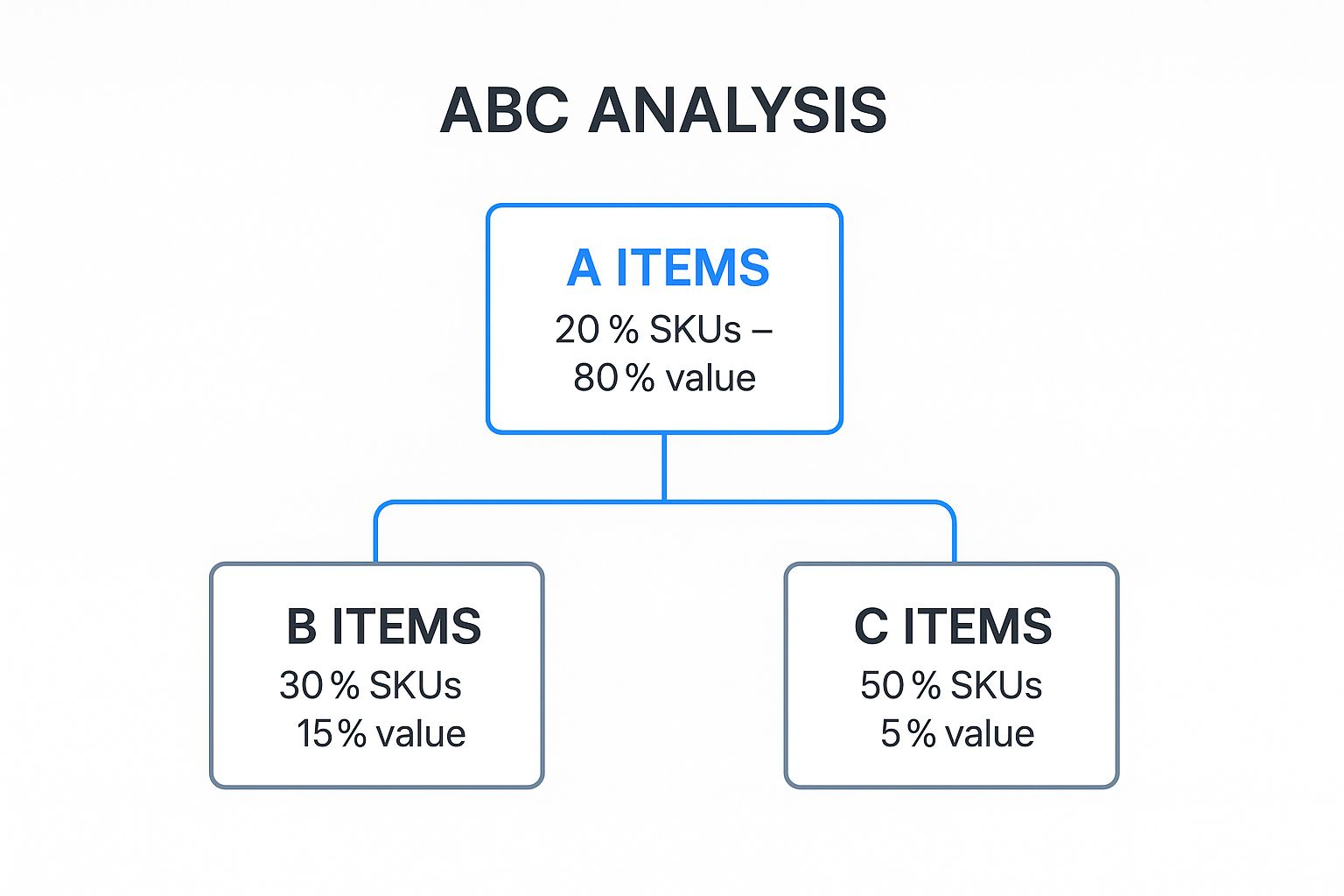Inventory is more than just stock on a shelf; it's cash waiting to be unlocked. For any e-commerce brand, from subscription boxes to specialized Shopify stores, mastering inventory management is the critical link between satisfying customers and maintaining a healthy bottom line. The right strategy can reduce carrying costs, improve cash flow, and prevent the dreaded stockout, while the wrong one leads directly to wasted capital and missed opportunities.
However, there is no single solution that fits every business. The key is understanding the diverse methods of inventory management available and choosing the right combination for your unique products, sales velocity, and operational goals. Modern operational shifts, like the impact of 3D printing on supply chain, continually reshape how businesses approach stock levels and production, making strategic agility more important than ever.
This guide breaks down 10 essential inventory methods, providing the practical insights you need to build a resilient and profitable fulfillment operation. We will explore everything from Just-In-Time (JIT) and ABC analysis to vendor-managed systems, helping you identify the specific techniques to optimize your stock, delight your customers, and fuel sustainable growth.
Just-In-Time (JIT) is one of the most efficient methods of inventory management, where you order and receive goods only as they are needed for production or to fulfill customer orders. This strategy aims to drastically reduce inventory holding costs and waste by keeping stock levels at an absolute minimum. The core principle is simple: produce and deliver finished goods "just in time" to be sold, subassemblies "just in time" to be assembled, and raw materials "just in time" to be transformed.
This system, famously pioneered by Toyota, relies on a highly synchronized and predictable supply chain. For e-commerce brands, this means products arrive from suppliers precisely when customer demand dictates, eliminating the need for vast, expensive warehouse space.

JIT is ideal for businesses with reliable demand forecasting, stable production schedules, and highly dependable suppliers. It excels for companies selling products with short life cycles or customizable items, like Dell's build-to-order computers. By avoiding overstocking, businesses can minimize losses from obsolete inventory and improve cash flow.
Implementing this requires careful planning and a deep understanding of your supply chain. You can learn more about the intricacies of the Just-In-Time inventory system to see if it's the right fit for your brand.
ABC Analysis is a foundational inventory categorization technique, one of the most effective methods of inventory management for prioritizing resources. It involves sorting inventory into three distinct categories (A, B, and C) based on their consumption value. This method allows you to apply different management strategies to each category, focusing your efforts where they have the most significant financial impact.
The principle, derived from the Pareto Principle, suggests that a small percentage of your items account for the majority of your inventory value. For instance, Category A items are your high-value products, Category B are mid-range, and Category C are your low-value, high-quantity goods. Giants like Amazon and Walmart use this to optimize warehouse placement and stocking levels across millions of SKUs.
The infographic below visualizes this hierarchical breakdown, showing how a small portion of stock-keeping units (SKUs) represents the majority of inventory value.

This hierarchy clearly illustrates why focusing management efforts on the 'A' items provides the highest return on investment for inventory control.
This method is perfect for businesses with a diverse range of products that vary significantly in value and sales volume. If you feel overwhelmed managing every SKU with the same level of scrutiny, ABC Analysis provides a framework to strategically allocate your time, capital, and labor. It's especially useful for improving cash flow by preventing overstocking on high-cost 'A' items and avoiding stockouts of critical products.
By segmenting your inventory, you can create a far more efficient and cost-effective management system. You can explore more inventory control methods like ABC Analysis on simplfulfillment.com to see how they integrate.
The Economic Order Quantity (EOQ) model is a classic and powerful formula among methods of inventory management used to calculate the ideal order size. Its primary goal is to find the perfect balance that minimizes the combined costs of ordering inventory and holding it in your warehouse. The formula weighs setup costs, like shipping and processing, against holding costs, such as storage fees and insurance.
Developed by Ford W. Harris in 1913, this method helps businesses answer a critical question: "How much product should I order at one time?" By identifying the optimal order quantity, EOQ helps prevent excessive spending on both frequent, small orders and infrequent, large orders. It's a mathematical approach to achieving cost-efficiency in your supply chain.
EOQ is best suited for businesses with relatively stable and predictable demand for their products. It works well for companies that can accurately forecast sales and have consistent ordering and holding costs. For example, a manufacturer ordering raw materials or an office supply company restocking standard items can use EOQ to streamline purchasing and reduce expenses. It provides a solid, data-driven foundation for inventory decisions.
While EOQ assumes constant demand, it is a foundational tool. You can learn more about how to forecast inventory to provide the accurate data this model needs to be effective.
First-In, First-Out (FIFO) is a fundamental inventory management method where the first goods purchased or produced are the first ones sold. This approach ensures a chronological flow of inventory, preventing older stock from being left behind. It is one of the most widely used methods of inventory management, especially for products with a limited shelf life, as it naturally rotates stock and minimizes the risk of spoilage, obsolescence, or expiration.
This system is not just an operational practice but also a crucial accounting principle under GAAP. For e-commerce brands, especially in food, cosmetics, or electronics, FIFO ensures customers receive fresh, high-quality products while the company accurately reflects inventory value on its balance sheet.

FIFO is essential for any business dealing with perishable or time-sensitive goods. It is the standard for grocery stores rotating dairy, pharmacies dispensing medication by expiration date, and fashion retailers clearing out seasonal collections. If your product can degrade, expire, or become outdated, such as supplements or electronics with newer models on the horizon, FIFO is the non-negotiable method to protect both product integrity and profitability.
Last-In, First-Out (LIFO) is an inventory valuation method where the most recently acquired goods are assumed to be sold first. This means the cost of the newest inventory is matched against current revenues, leaving older, often cheaper inventory on the balance sheet. LIFO is one of the key methods of inventory management used primarily for accounting and tax purposes, especially in the United States during periods of rising prices.
Unlike FIFO, LIFO rarely reflects the actual physical flow of goods, as businesses typically sell their oldest stock first to prevent spoilage or obsolescence. Instead, its main advantage is tax-related: by expensing higher, more recent costs, it can reduce reported profits and, consequently, lower a company's tax liability during inflationary times. It is prohibited under International Financial Reporting Standards (IFRS).
LIFO is best suited for U.S.-based companies dealing with non-perishable goods in industries with consistently rising costs, such as raw materials or commodities. For example, oil and gas companies or metal distributors use LIFO to manage the accounting impact of volatile commodity prices. It is a strategic choice for businesses looking to minimize their taxable income during inflationary periods.
Implementing LIFO is a complex accounting decision with long-term financial consequences. You can learn more about the differences between LIFO and FIFO to determine which valuation method aligns with your business goals.
A Perpetual Inventory System is one of the most accurate methods of inventory management, providing a real-time, continuous count of stock levels. This system automatically updates inventory records immediately after every transaction, including sales, purchases, returns, or adjustments. By leveraging technology like barcode scanners, RFID, and integrated inventory software, businesses gain up-to-the-minute visibility into their stock.
This method eliminates the guesswork associated with periodic counting and empowers dynamic decision-making. Major retailers like Amazon and Target rely on sophisticated perpetual systems to manage their vast and complex supply chains, ensuring product availability and optimizing stock flow from warehouse to customer.

This system is essential for businesses with high transaction volumes, a large number of SKUs, or multiple sales channels (online and in-store). It is particularly effective for e-commerce brands needing precise stock data to prevent overselling and manage customer expectations. If you need accurate, live data to make purchasing, marketing, and sales decisions, a perpetual system is the gold standard.
The Periodic Inventory System is a straightforward method of inventory management where you don't track inventory in real-time. Instead, you conduct physical inventory counts at specific, scheduled intervals, such as monthly, quarterly, or annually. Between these counts, the inventory account remains unchanged.
After a physical count, the Cost of Goods Sold (COGS) for the period is calculated using the formula: Beginning Inventory + Purchases – Ending Inventory = COGS. This approach is less complex than continuous tracking, making it suitable for smaller businesses. It’s a trade-off between simplicity and real-time accuracy.
This system is best suited for small businesses with a manageable number of SKUs where constant tracking would be cost-prohibitive. It works well for small independent retail shops, antique stores with unique items, or art galleries where each piece is one-of-a-kind. If your sales volume is low and you can afford to have less precise inventory data between counts, this method is a practical starting point.
Dropshipping is one of the more unique methods of inventory management where the retailer holds zero physical stock. Instead, when a customer places an order, the retailer purchases the item from a third-party supplier, who then ships the product directly to the customer. This model eliminates warehousing costs, inventory risk, and the complexities of fulfillment logistics.
Effectively, the business acts as a marketing and customer service front, managing the storefront and customer relationships without ever handling the products. This approach, popularized by platforms like Shopify and supplier networks like AliExpress, allows e-commerce brands to offer an extensive catalog of products with minimal upfront investment.
This method is perfect for entrepreneurs testing a new market or product idea with low initial capital. It's also ideal for businesses selling a vast range of niche products, like online fashion boutiques or specialty electronics stores, where stocking every variation would be financially prohibitive. By removing the inventory burden, businesses can focus their resources entirely on customer acquisition and brand building.
For those new to this model or looking to refine their approach, a comprehensive guide on how to start a dropshipping business can provide a detailed roadmap for success.
Consignment is a unique entry among methods of inventory management where a supplier (consignor) provides goods to a retailer (consignee) but retains ownership until the product sells. The retailer only pays for the items after they are sold to the end customer, shifting the financial risk of holding inventory from the retailer back to the supplier.
This arrangement benefits retailers by freeing up capital that would otherwise be tied up in inventory and reducing the risk of losses from unsold stock. For suppliers, it offers a low-risk way to introduce new products or enter new markets, as retailers are more willing to stock items they don't have to purchase upfront. This model is common in industries with high-value items or unproven demand, such as art galleries, luxury fashion boutiques, and antique malls.
Consignment inventory is ideal for e-commerce brands looking to get their products into physical retail locations without convincing buyers to make a large upfront purchase. It works well for new or high-end products where consumer demand is uncertain. It also benefits suppliers by ensuring products are available and visible to customers, which can be a significant competitive advantage.
Vendor-Managed Inventory (VMI) is one of the most collaborative methods of inventory management, where the supplier takes full responsibility for maintaining a customer's inventory levels. Instead of the retailer placing purchase orders, the vendor monitors stock data, often through shared systems, and decides when to replenish and how much to send. This shifts the decision-making burden from the buyer to the supplier.
This model, famously pioneered by Walmart and Procter & Gamble, fosters a true partnership. The supplier gains visibility into real-time demand, allowing for better production planning, while the retailer reduces the risk of stockouts and lowers administrative costs associated with purchasing. It’s a win-win that optimizes the entire supply chain.
VMI is highly effective for businesses with high-volume, predictable products and strong, long-term supplier relationships. It works exceptionally well in retail, where brands like Coca-Cola manage their own products on store shelves, and in manufacturing, where component suppliers ensure assembly lines never stop. For e-commerce brands, it can streamline operations for core, fast-moving products.
Navigating the diverse landscape of inventory management methods can feel complex, but the journey from understanding to implementation is where true competitive advantage is forged. We've explored a range of powerful techniques, from the lean efficiency of Just-In-Time (JIT) and the strategic prioritization of ABC Analysis to the precise financial calculations of Economic Order Quantity (EOQ). Each method offers a unique lens through which to view and control your most valuable asset: your stock.
However, the key takeaway is that these methods are not mutually exclusive. The most agile and successful e-commerce brands rarely rely on a single, rigid system. Instead, they build a dynamic, hybrid strategy that cherry-picks the best elements for their specific business model. This strategic integration is the cornerstone of effective inventory control.
Think of these methods as tools in a toolkit. You wouldn't use a hammer for every job, and the same logic applies here. A practical, high-growth strategy might look something like this:
This layered approach transforms a simple list of methods of inventory management into a cohesive, responsive, and powerful operational engine. It allows you to be both strategic in your planning and precise in your execution.
Implementing and managing such a sophisticated system in-house can be a significant operational drain, pulling focus away from core growth activities like marketing and product development. This is precisely where a strategic partnership with a third-party logistics (3PL) provider becomes a powerful lever for growth.
Outsourcing your fulfillment allows you to tap into existing expertise and technology without the massive upfront investment. An advanced 3PL can seamlessly execute the complex physical and digital requirements of your chosen inventory strategy. They manage the warehouse, implement FIFO protocols with precision, and provide the integrated software needed for a real-time perpetual system. By offloading the logistical execution of your inventory methods, you don't just save time and money; you gain a scalable foundation built for future success, ensuring your inventory remains a well-oiled asset, not a growth-limiting liability.
Ready to transform your inventory management from a daily challenge into a competitive advantage? Partner with Simpl Fulfillment to leverage our expert teams and advanced technology, perfectly executing the methods you need to scale efficiently. Explore how Simpl Fulfillment can streamline your operations today!